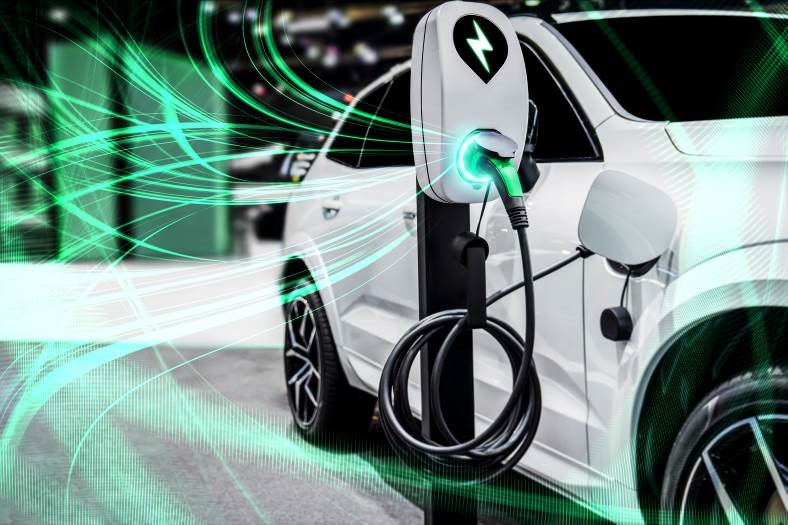
Chinese NEV production and sales increased by 33.9% and 37.8% year-on-year from January to October in 2023.(Photo: iStock)
 Plastics Industry Players to Boost Intelligentization, Lightweighting, and Decarbonization of New Energy Vehicle
Plastics Industry Players to Boost Intelligentization, Lightweighting, and Decarbonization of New Energy Vehicle
The Chinese automotive market has gradually regained momentum in 2023 where the performance of new energy vehicle (NEV) is particularly eye-catching. Under the trend of “reverse joint venture” and “exporting technology", what are the materials and processing technologies needed for the NEV sector to bringing a safer, more comfortable and sustainable experience?
According to the data released by the China Association of Automobile Manufacturers (CAAM), China's automobile production and sales increased by 8% and 9.1% year-on-year from January to October respectively, while NEV production and sales increased by 33.9% and 37.8%, with a market share of 30.4%; and NEV exports reached 995,000 units, up 99.1% year-on-year.
Source:AdsaleCPRJ(www.AdsaleCPRJ.com)
Young consumers pay more attention to NEV. Relevant research studies show that consumers under 30 years old account for up to 43% of NEV users. In addition, young consumers prefer NEVs of high aesthetic appeal.
As the front facade of new generation of automobiles, intelligentized front grille is becoming the mainstream of the industry, and advances in injection molding technology and new materials also play important roles.
Some examples that spring to mind include the kidney-shaped front grille of the BMW iX series, which adopts ENGEL's integration processing to achieve a 3D effect; Magna’s intelligentized front grille, which uses Mezzo panels made of polycarbonate to achieve a highly translucent visual effect; and Hyundai Mobis uses advanced lenticular lens sheet film to make the lens grille lighting module look slimmer and lighter.
In addition to intelligentized front grille, automakers have also injected new ideas into smart car lighting with the help of processing and material technologies.
For example, the headlights of BYD’s YANGWANG U8 model are manufactured by Tederic NEO M27220 injection molding machine to achieve high-precision molding; the headlights of Li Auto’s L9 model are manufactured by large multi-color injection molding machines; HiPhi uses Covestro's polycarbonate solutions for the headlight and LiDAR grills of its latest luxury SUV. In addition, Wanhua Chemical 's multi-color PMMA adds color to smart taillights without coloring and spraying, reducing carbon emissions.
With the rapid development of smart cars, the charging port of the car is more aesthetic, intelligentized and user-friendly, giving users a better charging experience.
For example, the charging port cover of Audi's all-electric e-tron series is made of AKRO-PLASTIC’s fiber reinforced AKROLOY® PA GF 60 black (6418) polyamide; WM Motor uses PPE+PA to manufacture charging port cover, which is lightweight and safe; Röchling has introduced an automatic charging port cover made of biopolymer.
As NEV takes great leap forward, the driving range increases at the same time, from more than 500 km to 1,200 km. For every 100 kg of weight reduction in NEV, the driving range can be increased by 10%-11%, while the costs of battery and daily wears can be reduced by 20%. Therefore, lightweighting has become a focus of innovation for major automakers and parts manufacturers because it leads to improvement of efficiency of the powertrain and optimizes the driving range of the vehicle. Each automaker has its own strategy, using new materials and advanced processing technologies to "slim down" vehicles.
Toyota, BASF and US Farathane have co-developed resin frames to create ISO dynamic seats for the first time, which can reduce costs by 20% and weight by 30%. Besides, FORVIA’s latest solution for seat back panels, Skin Light Panel, is made of mono- material polymer (PU) through 3D carving, reducing weight by 20%-30%. Marelli has also teamed up with Covestro to develop a new lightweight polyurethane foam that reduces the weight of the main cockpit panel by 40%.
In addition to weight reduction of front-end and cockpit modules, the battery pack, which accounts for 20%-30% of the weight of the whole vehicle, has also been a key part for lightweighting in recent years.
General Motors' 2023 Cadillac pure electric vehicle (EV) Lyriq uses PA6/12, PA66, and PP from DuPont, DOW, and LyondellBasell. Through extrusion, injection molding, foaming and automatic assembly, the materials are processed into thermoplastic BEV pipes of the thermal management system. The multi-layer pipes not only have excellent chemical resistance, but also achieve 60% weight reduction.
In addition, Solvay's Ajedium™ PEEK slot liners reduce the weight of battery pack and motor by 12 kg and 4 kg respectively. Mitsubishi Chemical has teamed up with partners to develop a full-composite casing for EV battery, reducing the number of components from five to two, ultimately achieving weight reduction in the battery casing. Wanhua Chemical's HP-RTM polyurethane battery case is also innovative and can reduce weight by 40%-50%.
Processing technology, including integrated molding and foaming, plays a key role in the lightweighting of NEV, such as ENGEL’s integrated molding of front-end module of NEV, KraussMaffei’s physical foaming process, Haitian International’s micro-foaming process, etc.
Automakers are raising the bar of voltage system in NEV from 400 V to 800 V. According to Joule's Law, the efficiency of the motor of a vehicle increases with a high-voltage system, thus improving driving range and reducing cost of the battery.
Under high voltage, the motor and battery with significantly higher operating temperature require better thermal management, which means the materials should have the properties of high temperature resistance and flame retardant.
Major chemical producers, such as Solvay and DuPont, have successively launched high-temperature nylon, PPS, PEEK, polyamide film and other materials that are suitable for high-temperature electric drive systems to help motors operate efficiently.
A battery module of Audi’s e-tron is processed into independent injection molded part using EMS-GRIVORY's PA66 which is flame-retardant V0 grade. Suppliers such as SABIC and Envalior have launched corresponding flame-retardant polymers to ensure the safe operation of motor and battery module. Among them, SABIC’s new extrusion grade flame-retardant polymer is also suitable for battery pack manufacturing while Envalior's thermoplastic materials meet the requirements of battery module immersed insulating coolant.
Ultra-fast charging vehicle models are capable of completing charging in 5-10 minutes. According to Huawei MI data, it is expected that vehicle models based on high-voltage fast-charging platform will gain a market share of up to 5.8 million units by 2026, accounting for 50% of the overall sales of NEV.
With CATL, Sunwoda, Gotion High-tech, Greater Bay Technology, etc. launching ultra-fast charging batteries, more and more ultra-fast charging guns are using liquid-cooled fast-charging solution in the face of high-voltage, high-current, high-power transmission. That requires the charging gun and cable materials to have high thermal conductivity, strength and toughness.
Meeting the high requirements, Dow's HTE5015-90U thermally conductive silicone rubber and potting/sealing materials can quickly dissipate heat from the charging gun tip; BASF's Elastollan® thermoplastic polyurethane (TPU) 1180A10WDM optimizes charging cables for fast charging stations, making the cables more flexible and easy to use.
Carbon emission reduction has become the buzzword in the automotive industry. BMW, Volvo, Volkswagen, Benz, Great Wall, Geely and some other automakers have announced their targets and action plans for carbon neutrality. Using low-carbon and eco-friendly materials, such as recycled plastics, bio-based materials and spray-free materials, are ones of the most important measures for automakers to reduce carbon emissions.
Regarding recycled plastics, BMW and Volkswagen are gradually increasing the proportion of recycled plastics in new cars; Honda and Toray are exploring the potential application of chemically recycled nylon 6 in the automotive sector; Magna has introduced mono-material, 100% recyclable material for car seat foam cushion and trim parts.
Compared with conventional fossil-based materials, there is advantage of bio-based materials to lower the cost of raw material and have been favored by automakers in recent years. Concept cars such as KIA's EV3 and EV4 use natural fibers and mycelium to reduce carbon footprint. Polestar and Röchling are ready to launch the first bio-based thermal management cooling kettle.
Using spray-free materials is also an effective way to reduce carbon emissions. Toyota's interior uses BASF's spray-free polyamide, and Honda has joined hands with Mitsubishi Chemical to develop spray-free coloring PMMA that can be used for car body and interior.
Many examples demonstrate that automakers, parts manufacturers and materials suppliers are collaborating across the value chain to develop a sustainable roadmap for automotive plastics.
A number of automakers have affirmed that hydrogen energy is an inevitable choice for the strategic transformation of carbon neutrality. Hydrogen vehicles can be refueled in just 4-5 minutes and have a driving range of up to 500 km.
The BMW iX5 hydrogen fuel cell car has completed road testing in Europe; Hyundai’s NEXO has the highest sales volume in the world; Toyota’s CROWN SEDAN is equipped with three hydrogen storage tanks and has a comprehensive driving range of up to 820 km.
So what materials would have the potential in hydrogen vehicle applications? Hydrogen storage tank, which is indispensable for hydrogen vehicle, is mostly made of carbon fiber. Toray's high-strength carbon fiber is used for high-pressure hydrogen storage cylinder for 70 MPa vehicle; Evonik's amine curing agent VESTAMIN® is used for epoxy systems, and the company’s Ancamine® can be used for rapid infiltration of fiber, allowing the tank to lose up to 70% of its weight.
Meanwhile, hydrogen storage tank liners require polymers with strong hydrogen barrier property to prevent from hydrogen leakage, such as Arkema's RILSAN PA11, which can be used to produce high-pressure hydrogen storage cylinder liners that are resistant to low temperatures and high-pressure hydrogen blistering.
More automakers are enriching their product matrices to embrace the approaching all-electric vehicle era and to meet the demand for luxury mobility in the Chinese market.
At 2023 China International Import Expo, 15 overseas automakers put NEV under the spotlight. At the same time, Benz, Jaguar Land Rover, Porsche, etc. have launched high-end EVs priced at more than one million yuan.
With Volkswagen taking a stake in XPENG Motors and Stellantis, Maserati's parent company, investing in Leapmotor, foreign automakers have reaffirmed the importance they attach to China's automotive market.
When it comes to the global market, the European Union will ban the sale of new petrol and diesel vehicles by 2035, and The Regional Comprehensive Economic Partnership Agreement (RCEP) has officially come into force, granting zero-tariff treatment to Chinese exports of automobiles and parts. These policies present opportunities to the automotive industry. Represented by Chery, Great Wall and BYD, Chinese automakers have enhanced their influence in their journey of exploring overseas markets.
As the saying goes, automakers are looking for breakthroughs under the trend of “reverse joint venture” and “exporting technology". The materials and processing technologies that boost intelligentization, lightweighting, and decarbonization of NEV will also face new challenges and opportunities. Are you ready?
Source: Adsale Plastics Network (www.AdsaleCPRJ.com)













